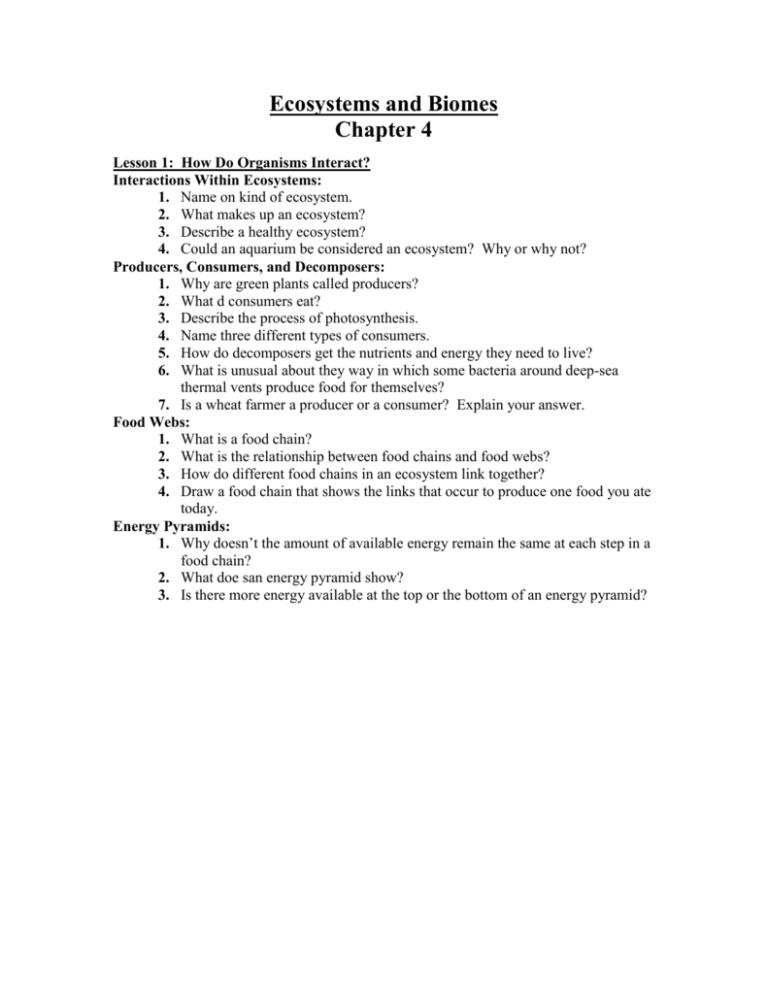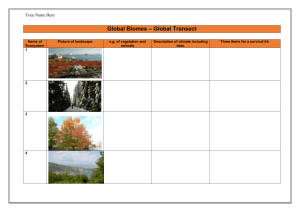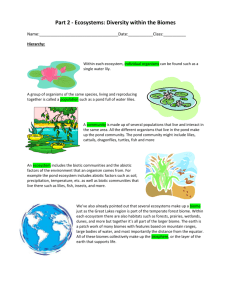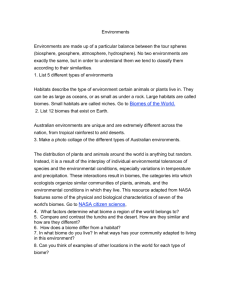ch 4a Ecosystems and Biomes
advertisement

Ecosystems and Biomes Chapter 4 Lesson 1: How Do Organisms Interact? Interactions Within Ecosystems: 1. Name on kind of ecosystem. 2. What makes up an ecosystem? 3. Describe a healthy ecosystem? 4. Could an aquarium be considered an ecosystem? Why or why not? Producers, Consumers, and Decomposers: 1. Why are green plants called producers? 2. What d consumers eat? 3. Describe the process of photosynthesis. 4. Name three different types of consumers. 5. How do decomposers get the nutrients and energy they need to live? 6. What is unusual about they way in which some bacteria around deep-sea thermal vents produce food for themselves? 7. Is a wheat farmer a producer or a consumer? Explain your answer. Food Webs: 1. What is a food chain? 2. What is the relationship between food chains and food webs? 3. How do different food chains in an ecosystem link together? 4. Draw a food chain that shows the links that occur to produce one food you ate today. Energy Pyramids: 1. Why doesn’t the amount of available energy remain the same at each step in a food chain? 2. What doe san energy pyramid show? 3. Is there more energy available at the top or the bottom of an energy pyramid? Chapter 4 Lesson 2: How Are Materials Recycled? Oxygen-Carbon Dioxide Cycle: 1. What two processes are part of the oxygen-carbon dioxide cycle? 2. What products result from respiration? 3. Where does respiration take place in living things? 4. Do you think it would be easier for plants to survive without animals or for animals to survive without plants? Nitrogen Cycle: 1. Why do living things need nitrogen? 2. What role do nitrogen-fixing bacteria play in the nitrogen cycle? 3. How do animals get nitrogen? 4. What is one way nitrogen may be returned to the air? Pollution Affects the Cycles: 1. What is pollution? 2. What effect does burning fossils fuels have on the oxygen-carbon dioxide cycle? 3. Why might increased amounts of carbon dioxide in the air cause global warming? 4. How do some fertilizers affect the nitrogen cycle? Chapter 4 Lesson 3: What Happens When an Ecosystem Changes? Environmental Changes 1. What kids of natural occurrences can change ecosystems? 2. What is El Nino? 3. When an ecosystem changes, what can happen to the organisms that live in that ecosystem? 4. What usually happens to populations when ecosystems change? Competition 1. What does the word competition mean when it is used in ecology? 2. Do you think that organisms compete only with other species for resources in ecosystems? Explain. 3. Do you think people have an unfair advantage in competing with other organisms for resources? Why or why not? 4. What specific characteristics of the hawk (on page A133) help it survive in an ecosystem? How might the hawk’s adaptations allow it to survive a major change in its environment? 5. What happens when a population increases? 6. Which organisms will survive when resources are limited? 7. Grasses are able to grow in a dry African savannah but water lilies are not. Why? People Affect Ecosystems 1. What are introduced species and how can they change an ecosystem? 2. What are two ways in which people can protect the environment? 3. Since tree are renewable resource, does cutting down trees still change an ecosystem? Explain your answer. Chapter 4 Lesson 4: What Are the Features of Land Biomes? Biomes: 1. What is a biome? 2. Explain how latitude affects biomes. 3. Where would you expect to find the warmest biomes? 4. What effect does altitude have on biomes? World Biomes: 1. Which biomes receive the greatest annual average precipitation? 2. Which biome has the greatest yearly temperature range? 3. Name a major factor that determines the kinds of organisms found in biomes. 4. What are the six major land biomes? 5. Which biome would you expect to find closest to the equator? Closest to the poles? Land Biomes: Tundra: 1. What is permafrost? 2. Name three animals you might encounter on the tundra. 3. What do all organisms that live in the tundra biome year-round have in common? Taiga: 1. What is the most common plant found in the taiga? Describe this plant. 2. Compare and contrast the seasons of the taiga and the tundra. Temperate Deciduous Forest: 1. How is the temperate deciduous forest different from the taiga? 2. What are deciduous trees? 3. Name two types of trees that grow in temperate deciduous forests. Grasslands: 1. Why are grassland biomes known as the “breadbaskets” of the world? 2. What do you think might happen to an orchid plant from the taiga if you moved it to a grassland? Explain. Tropical Rainforest: 1. Describe the temperature and precipitation conditions in a tropical rain forest. Desert: 2. What do all desert biomes have in common? 3. Are there more nutrients in the soils of a desert biome or a grassland biome? Explain your answer.









